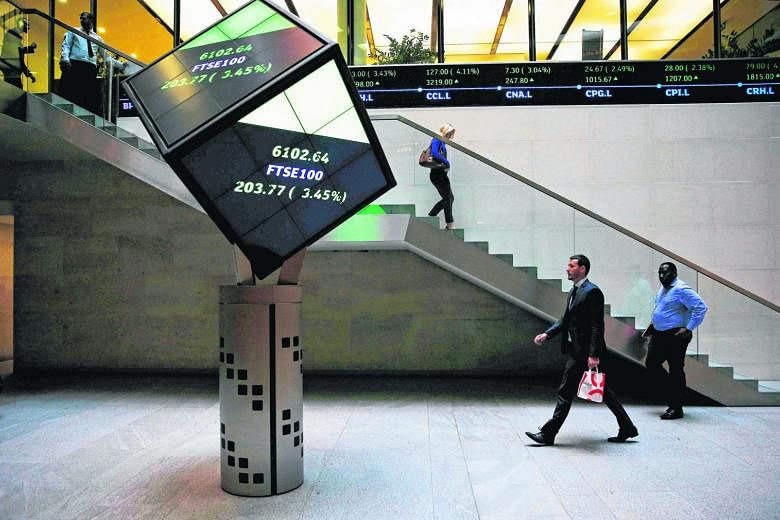When the Singapore Exchange (SGX) made its abortive A$8.4 billion bid for the Australian Stock Exchange in 2010, the local operator was valued at S$10.2 billion.
Little did market players know that this would be the high-water mark of the SGX's capitalisation since the 2008 global financial crisis. Since then, its share price has failed to reclaim that same lofty level, leaving the bourse operator valued at about $8.2 billion.
At around the same time, the LSE Group (LSEG), the owner of the London Stock Exchange and then worth only about £2.75 billion, had tried to get hitched to the TMX Group, which owned the Toronto Stock Exchange. But that courtship also ended up in grief.
Since then, however, the story of the two bourse operators has diverged considerably. While the SGX has stayed celibate and pursued a business strategy of organic growth, the LSEG has become a consolidator of other businesses. As a result, its market value has quadrupled to £10 billion (S$19 billion) in the past six years, more than twice as valuable as the SGX.
Then there is Intercontinental Exchange (ICE), the owner of the New York Stock Exchange (NYSE), whose story is worth recounting as well. ICE was established in the United States in 2000 - the year that the SGX got listed - as an alternative platform for trading energy to challenge the dominance of now-defunct US energy trading giant Enron.
 Growing via acquisitions is a well-trodden route. The London Stock Exchange (above), for instance, is in the midst of a merger with Deutsche Borse. PHOTO: REUTERS
Growing via acquisitions is a well-trodden route. The London Stock Exchange (above), for instance, is in the midst of a merger with Deutsche Borse. PHOTO: REUTERS When Enron collapsed the following year, in what was billed as the biggest US corporate scandal in history, ICE's business surged. The rest, as they said, is history. ICE is now worth about US$28 billion (S$38 billion).
That, of course, begs the question: What spawned the success of LSEG and ICE? This, given that the best days of stock exchanges are supposed to be over, with many of them losing their near-monopolies in clearing stock trades.
In some sense, both the LSEG and ICE enjoy similar scripts for success. For both bourse operators, equity trading now contributes less than 10 per cent of their total revenues.
Instead, the more lucrative activity is in clearing derivatives trades - a less visible and less exciting business than stock trading, which can grab headlines with big sexy listings such as that of Chinese technological giant Alibaba in New York two years ago.
For LSEG, one income spinner is its SwapClear division, which clears the bulk of the global trades on over-the-counter interest rate swaps - the private interest rate contracts traded by banks - to the tune of US$1 trillion daily.
Acting as the intermediary between buyer and seller, it assures both parties that their contracts will be settled in full without having to worry about each other's credit risk. And because derivatives clearing can take a long time, as contracts may sometimes stretch into months, it is a steady money-earner far less exposed to competition than a stock exchange.
That such a plum business should drop onto the LSEG's lap was the result of its acquisition of a majority stake in London-based clearing house LCH.Clearnet Group in 2012, after its failed attempt to merge with TMX.
Across the Atlantic, ICE enjoys the same sort of success story as a credit derivatives clearing house, as it stands as an intermediary between trades to reduce the counterparty risks of banks, asset managers and hedge funds.
Its moment of glory came in 2013 when it mounted a US$8.2 billion takeover of the NYSE Euronext.
ICE boss Jeff Sprecher made no secret that the trophy he sought was not the iconic symbol of US capitalism represented by the NYSE, but the Liffe European derivatives exchange that the venerable bourse operator owned.
There is one other observation worth highlighting: the inroads LSEG and ICE are making into the fast-growing markets for data and indexes, as exchange-traded funds soar in popularity worldwide.
The LSEG has, for example, expanded its indexes business as demand for specialist market data rises, by snapping up US index provider Frank Russell for US$2.7 billion two years ago.
As the LSE also owns the FTSE Group, another big index provider, the combined index business gives it leverage to launch more index products and derivatives in the international arena for traders. That has, in turn, enabled it to prosper further.
The same goes for ICE, which bought Interactive Data for US$5.2 billion last year as it aims shed the image that it is merely a commodity futures exchange and stock market operator.
Given the many lessons provided by the two bourse operators, it is heartening to find the SGX back in the hunt for overseas acquisitions, with a non-binding bid to buy London's Baltic Exchange, rather than getting caught up with distracting issues in the stock market, such as the minimum trading price and scrapping the lunch break.
If the SGX had been an ordinary listed firm, the challenges it faced as it coped with the rapidly changing international financial landscape would have been of little interest to the wider investing public.
But at the heart of every major financial centre lies a robust and vibrant stock exchange. That, in turn, spawns spin-offs that benefit the financial centre.
Unlike LSEG and ICE, the SGX still gets a considerable chunk of its revenues from clearing stock trades but, even then, the complexion of its business is changing.
Its October-to-December quarter shows that securities revenues made up 24 per cent of total turnover. That was far lower in percentage terms, compared with the same quarter six years ago when securities made up 47 per cent of SGX revenue.
In contrast, derivatives accounted for 40 per cent of its total revenues for the same quarter. This was double of the 20 per cent contribution it made six years ago.
No doubt, most of us still cling to the belief that stock exchanges are venues that give companies access to raise funds and where the members of the public get an opportunity to invest in promising companies to get a better return for their nest eggs. But if the experiences of the LSE and ICE are anything to go by, some of the most successful bourse operators are not merely stock exchanges any more. Instead, they operate powerful franchises in clearing derivatives trades and own rapidly growing businesses in data and indexes.
It is clear that when the dust settles on the latest round of consolidation among stock exchanges, such the merger between LSEG and Deutsche Borse, a few global bourse operators will dominate as low-cost clearers of trades.
For the SGX, the challenge is to become one of them.


